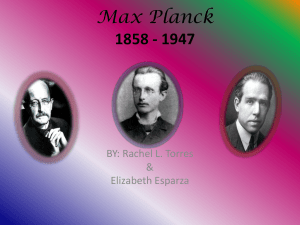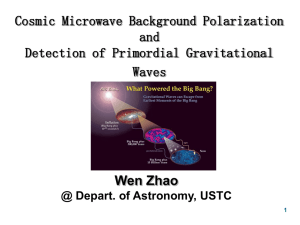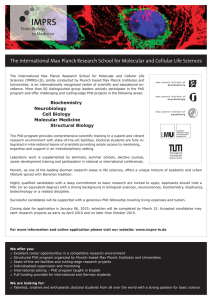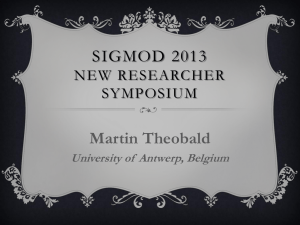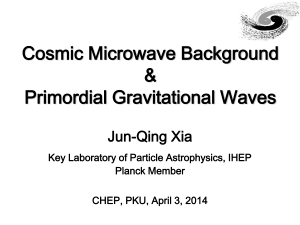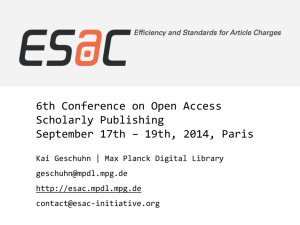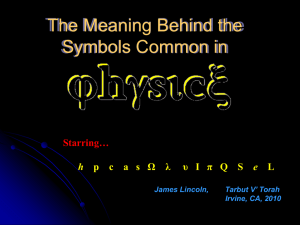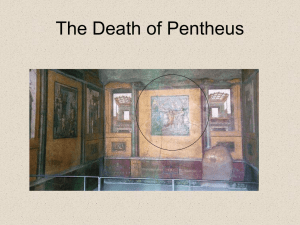Super CO survey with NANTEN2
advertisement
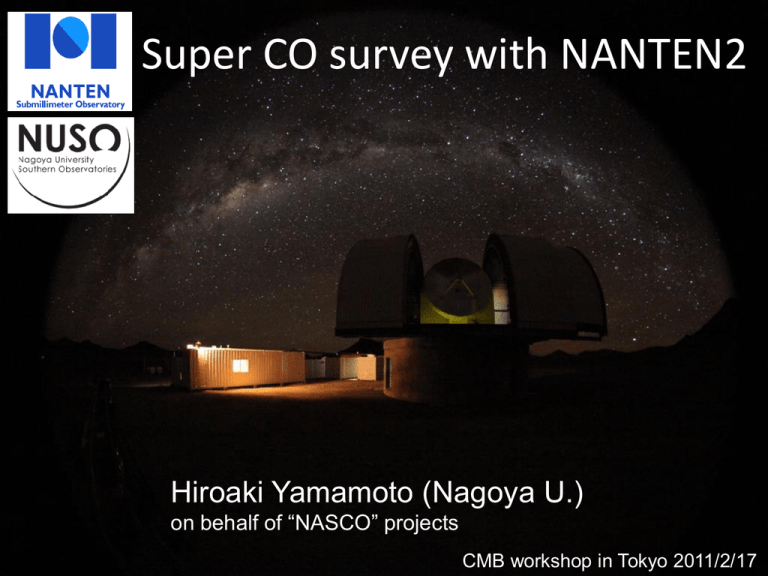
Super CO survey with NANTEN2 Hiroaki Yamamoto (Nagoya U.) on behalf of “NASCO” projects CMB workshop in Tokyo 2011/2/17 Contents • • • • • • • CMB Goal of study Why are CO observations needed ? Foreground sources of CMB obs. NANTEN GPS ver.1 (NGPS) Comparison of PLANCK results with NGPS NASCO Projects Research Group • Y. Fukui Leader ・ Global Analysis including NASCO • T. Okuda Development of NASCO receiver system, Observations • T. T. Takeuchi Modeling of foreground radiation, Development of component separation by statistical methods • K. Ichiki Theoretical study in terms of cosmology • S. Inutsuka Research for magnetic field and turbulence in ISM by MHD. • H. Maesawa Support of receiver developments • Collaborators (PLANCK members in IAS France) – J.-L. Puget: PI of HFI in Planck – F. Boulanger: PI of ERC Advanced Research Grants – J.-P. Bernard: Partner of Boulanger |Cosmic Microwave Background WMAP; Subtracted map of foreground sources Freq. (dF) [GHz] 23 (5.5), 33 (7.0), 41 (8.3), 61 (14.0), 94 (20.5) Main Results ・ Age ~ 13.7 billion years ・ Composition : baryon ~ 4%, dark matter ~ 23%, dark energy ~ 73% ・ Corresponding to an inflation scenario with the results ・ Non detection of B mode polarization due to poor sensitivity Goal of Study Detection of B mode polarization in CMB Giving Strong Constraint from observations to proposed inflation models. B mode polarization is so weak that it has been never detected so far. Some foreground sources are higher fractional polarization than expected for the CMB signals Problem is poor knowledge about the amplitude and scale of the polarization of foreground emission Planck can identify large angular scale B mode amplitude. Important thing is understanding nature of the foreground sources Why are CO observations needed ? In case of WMAP Key component to subtract at microwave ・Synchrotron Galactic center ・Free-free emission LFI HFI 12CO(J=1-0) ・Dust radiation 200MHz CF 30 44 70 100 143 217 353 545 857 WMAP Maximum Frequency 104GHz SF 27 :39.6 63 83.5 119.4 ~181.2 294.8 455.1 715.6 Contribution of CO is not included EF 33 48.4 77 116.5 166.5 252.8 411.2 634.9 998.4 PLANCK: Gold et al. 2011, ApJS, 192,15 Component maps by Maximum Entropy VLSR (km/s) Method (MEM) analysis CO(J=1-0) 109,110,115 GHz CO(J=2-1) 219,220,230 GHz CO(J=3-2) 329,330,345 GHz Strongest line emission in MCs. Contaminated in observed bands. One year all sky survey by Planck Planck all-sky foreground maps The Galactic Cold Core Population Planck Early Results: The Galactic Cold Core Population Revealed by the First All-Sky Survey Ade et al. (2011) the density of cold cores in the Milky Way through its three highest frequency channels. Cold clumps vs CO clouds Planck Early Results: The Galactic Cold Core Population Revealed by the First All-Sky Survey Ade et al. (2011) CO: Dame et al. (2001) 7.5’ – 30’ grid at HPBW of 8.8’ Resolution of CO survey by Dame et al. is not enough to compare with Planck data. New CO data is … NANTEN GPS ver.1 (NGPS) NANTEN 12CO(J=1-0) Integrated Intensity map 600 km s-1 HFI 100GHz vs NGPS Planck results with NGPS 30GHz 353GHz 857GHz Orion Composite image of above 3 images NANTEN 12CO (J=1-0) Planck results with NGPS Composite image of 557GHz, 857GHz and IRAS 100 um Ophiuchus to Aquila NANTEN 12CO (J=1-0) NAnten Super CO survey (NASCO) • New Survey with OTF by NANTEN2 at Atacama (Alt. 4865m) in 12CO and 13CO(J=1-0) simultaneously. • Survey beyond NGPS • Covering 70% area of whole sky Survey Name Coverage (deg) HPBW (‘) Grid (‘) Vel cov. (km/s) Vel reso. (km/s) RMS[K]@ 1km/s reso. Total points (million) NGPS 200<L<60,B<|10| 2.6 4-8 ±300 1.0 ~0.35 1.1 NASCO 70% of sky 2.6 1 ±1300 0.16 ~0.2 20 NAnten Super CO survey (NASCO) Expected results NASCO: Large Scale mapping in CO never done before • Covering 70% of whole sky • Enabling us comparative study with PLANCK • Implementation of an estimation of CMB B mode component by progressing the study of foreground sources Breakthrough for ISM study etc. • Comparative study with sub-mm, infrared (Herschel, AKARI) to gamma-ray (Fermi etc.) in large scale • Spreading effect as historical common property in Astronomy NAnten Super CO survey (NASCO) Current status • Collaboration with Planck satellite – 1991:start collaboration with IAS in France (Fukui) – 2007:Launch WG7 group (Planck consortium) and conclude a MoU with the WG7 group on the use of NGPS in order to estimate foreground components. – 2010:Proposal of NASCO • Development of NASCO test receiver – 2010/4:Start to develop – 2011/1:Installing in NANTEN2 and checking system NASCO test receiver system NAnten Super CO survey (NASCO) Schedule 2011-2015 ○ Carrying out Super large scale mapping in CO (NASCO) ○ Total Analysis Estimation of density and velocity structures in ISM using NASCO and HI dataset Establish of 3D magnetic field model in the Milky Way from polarization from PLANCK CMB dataset: Planck, BICEP, EBEX, SPIDER etc. ISM dataset :NASCO, PILOT, BLAST, EoR, CGPS, SGPS, GASS • 2011: – Observation by a test receiver, Development of NASCO receivers – Comparative study / modeling of the ISM by using NGPS and PLANCK • 2012-2015: – Observations by NASCO receivers – Establishing Higher accurate ISM model – Estimation of CMB B mode polarization, constraint to inflation models Summary • PLANCK dataset includes CO components as well as synchrotron, free-free emission and dust radiation in microwave. • It is important to remove the contribution of CO gas and related foreground sources to detect weak CMB B mode polarization • NASCO Project is now on going to compare the Planck data with MCs.
